
Acronicta is a genus of noctuid moths containing about 150 species distributed mainly in the temperate Holarctic, with some in adjacent subtropical regions. The genus was erected by Carl Linnaeus in his 1758 10th edition of Systema Naturae. Caterpillars of most Acronicta species are unmistakable, with brightly colored hairy spikes, and often feed quite visibly on common foliate trees. The hairy spikes may contain poison, which cause itchy, painful, swollen rash in humans on contact. The larva of the smeared dagger moth is unusually hairy even for this genus. Acronicta species are generally known as dagger moths, as most have one or more black dagger-shaped markings on their forewing uppersides. But some species have a conspicuous dark ring marking instead.

Alexicles is a monotypic genus of tiger moth genus in the family Erebidae. Its only species, Alexicles aspersa, the Alexicles moth, is found in the US states of New Mexico and Arizona. Both the genus and species were first described by Augustus Radcliffe Grote in 1883.
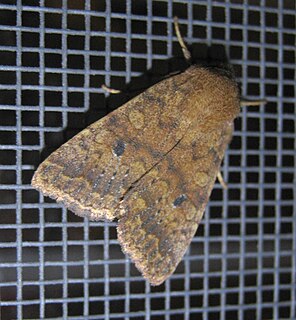
The Xylenini are a mid-sized tribe of moths in the Hadeninae subfamily. There is some dispute about this tribe. Some resources have these genera listed under subfamily Cuculliinae instead, or upranked them to a distinct subfamily Xyleninae.
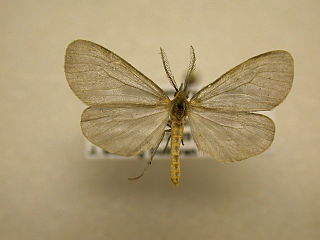
Pagara is a monotypic moth genus in the family Erebidae. Its only species, Pagara simplex, the mouse-colored lichen moth, is found in North America, where it has been recorded from Alabama, Arkansas, Florida, Georgia, Illinois, Indiana, Iowa, Kansas, Kentucky, Maryland, Mississippi, New Hampshire, North Carolina, Ohio, Oklahoma, South Carolina and Tennessee. Both the genus and species were described by Francis Walker in 1856.
Trocodima is a genus of moths in the family Erebidae. The genus was described by Watson in 1980.

Abagrotis is a genus of moths of the family Noctuidae.

Copivaleria is a monotypic moth genus of the family Noctuidae erected by Augustus Radcliffe Grote in 1883. Its only species, Copivaleria grotei, or Grote's sallow, was first described by Herbert Knowles Morrison in 1874. It is found in eastern North America, including Ontario, Tennessee, New York and Maryland.
Zelicodes is a monotypic moth genus in the family Erebidae. Its only species, Zelicodes linearis, is known from the US state of Arizona. Both the genus and species were first described by Augustus Radcliffe Grote, the genus in 1896 and the species in 1883.
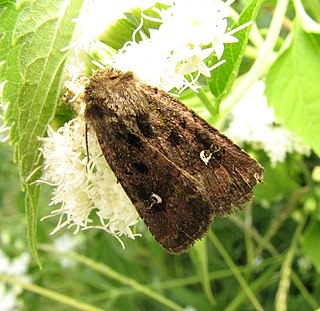
Lacinipolia is a moth genus in the family Noctuidae.
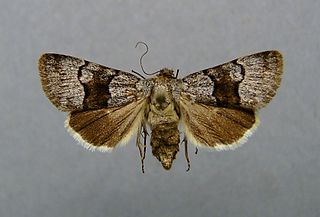
Sympistis is a genus of moths of the family Noctuidae. The genus was erected by Jacob Hübner in 1823.

Digrammia was a genus of moths in the family Geometridae erected by Carl Freiherr von Gumppenberg in 1887. It is now often considered a synonym of Semiothisa.

Apamea plutonia, the dusky Quaker or dusky apamea, is a moth of the family Noctuidae. The species was first described by Augustus Radcliffe Grote in 1883. It is native to northern North America, where it occurs across the boreal regions, with some occurrences from as far south as New Mexico and Pennsylvania.
Anarta decepta is a moth of the family Noctuidae. It was described by Augustus Radcliffe Grote in 1883 from Colorado and is found along the Pacific Coast of the United States and Canada. It was first discovered in Hawaii in light trap catches made in the Pearl Harbor area on Oahu in the autumn of 1947.
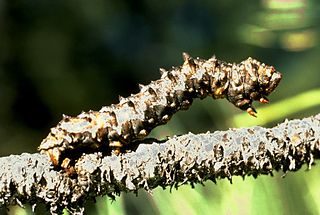
Phaeoura mexicanaria is a species of moth of the family Geometridae first described by Augustus Radcliffe Grote in 1883. It is found in North America, including British Columbia, California, Texas and Washington.
Inopsis funerea is a moth of the family Erebidae. It was described by Augustus Radcliffe Grote in 1883. It is found in North America, where it has been recorded from Arizona and South Carolina.
Evergestis obliqualis is a moth in the family Crambidae. It was described by Augustus Radcliffe Grote in 1883. It is found in North America, where it has been recorded from Arizona, California, Colorado, New Mexico, Texas and Utah.
Loxostege indentalis is a moth in the family Crambidae. It was described by Augustus Radcliffe Grote in 1883. It is found in North America, where it has been recorded from California, Nevada, Utah, Oregon, Washington and Montana.
Prosoparia perfuscaria, the inornate prosoparia moth, is a moth in the family Erebidae described by Augustus Radcliffe Grote in 1883. It is found in North America.
Stiriini is a tribe of owlet moths in the family Noctuidae. There are at least 120 described species in Stiriini.
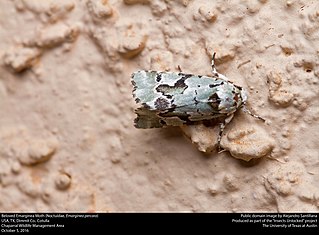
Psaphidini is a tribe of owlet moths in the family Noctuidae. There are at least 40 genera and at least 90 described species in Psaphidini.










